CPC Definition - Subclass G05G
This place covers:
Operator control devices (e.g. knobs, buttons, levers, joysticks or pedals) or systems insofar as characterised by mechanical features only, i.e. the element which the operator is manipulating or actuating, to generate control commands.
The following model describes the operator control device:
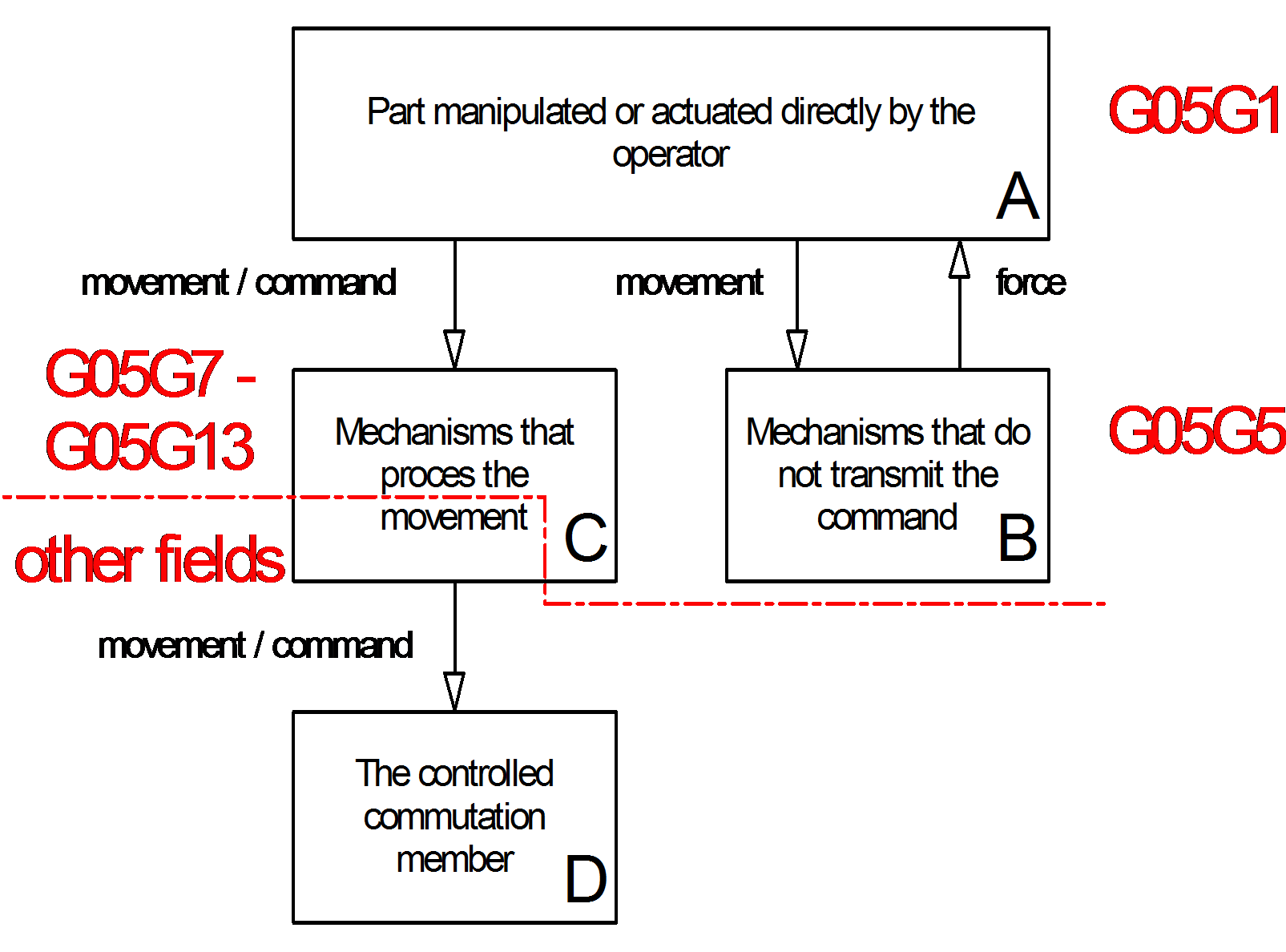
A) an operator actuated part (the part coming in contact with the human body to receive a command)
B) mechanisms that do not transmit the command (e.g. ratchet mechanisms, mechanisms with hysteresis, return spring mechanisms)
C) command treating mechanisms (i.e. mechanical systems aimed at transmitting, amplifying, converting or delaying the command received)
D) a commutation part (aimed at performing the final operation, e.g. electric contact being actuated).
If the invention is concerned with C, and the mechanism is a mechanism in which:
1. the ratio of motion or force between the controlling member and the controlled member is altered (e.g. US 2009/0095100 with brake pedal, which includes a mechanism capable of varying a ratio between an output amount of a push rod connected to a master cylinder and an operation amount of the brake pedal),
2. repeated movement of the controlling member produces increments of movement of the controlled member (e.g. US4311060 a parking brake in which, when the brake handle is pulled up, the brake cable is winded around a rotating member. By repeating the above operation of the brake handle, the rotating member is intermittently rotated until necessary length of the brake cable is wound up to effect firm locking of the parking brake), or
3. repeated movement of the controlling member moves the controlled member through a cycle of distinct positions (e.g. US3187602; push button wherein a contact is switched on or off by repeated pushing),
it is classified in groups G05G 7/00 - G05G 13/00
If the invention is concerned with C, and it is not one of the mechanisms under point 1 - 3 above, it is classified in other fields, e.g. H01H, B60K 35/00, F16H 59/00 - F16H 63/00, G06F 3/00, B62K, F24C, etc.
If the invention is concerned with D, it is classified in other fields, e.g. H01H, B60K 35/00, F16H 59/00 - F16H 63/00, G06F 3/00, B62K, F24C, etc.
This place does not cover:
Means for transmitting linear movement in a flexible sheathing, e.g. "Bowden mechanisms" | |
Adjustable cranks or eccentrics | |
Gearings or mechanisms not intended for mechanical control | |
Speed changing or reversing mechanisms for gearings conveying rotary motion |
Examples of places where the subject matter of this place is covered when specially adapted, used for a particular purpose, or incorporated in a larger system:
Controls for adjusting operating tables | |
Controls for adjusting operating chairs | |
Accessories for games using an electronically generated display | |
Manipulators or controls therefor | |
Arrangement or mounting of change speed gearing control devices in vehicles | |
Arrangement or mounting of propulsion-unit control devices in vehicles | |
Vehicle brake-action initiating means | |
Adaptations of control devices for movable vehicle cabs | |
Cycle steering devices | |
Rider operated controls for cycles | |
Brake actuating means for cycles | |
Marine steering initiating means | |
Controls for elevators | |
Control systems or devices for cranes | |
Arrangements of handles or pedals for crane operation | |
Control devices for dregging or soil-shifting machines | |
Automatic clutches | |
Control for valves | |
Safety devices acting in conjunction with the control or operation of a machine | |
Stopping machines on occurence of dangerous conditions | |
Micromanipulators structurally combined with microscopes | |
Driving mechanisms in clocks or watches | |
Digital computers in which all the computation is effected mechanically | |
Manual computer input arrangements | |
Converting a pattern of mechanical signals into electric signals | |
Displacement of solid control elements in nuclear reactors | |
Mechanisms for operating switch contacts | |
Mechanical control of resonant circuits |
Command treating mechanisms, i.e. mechanical systems aimed at transmitting, amplifying, converting or delaying the command received are considered as part of the related application and will be classified in the application place.
In this place, the following terms or expressions are used with the meaning indicated:
Controlling member | Knob, handle, lever, disc, wheel, joystick, pedal, etc. , and consists of: Part manipulated or actuated directly by the operator (part A in the model of the operator control device), and the mechanism that does not transmit a command (part B in the model of the operator control device), andthe mechanism that processes the movement (part C in the model of the operator control device) from the operator actuated part to the controlled member. |
Controlled member | The controlled commutation member (part D in the model of the operator control device), e.g. electric switch, sensor, valve or gear shifter yoke. |
Control mechanism | Mechanism that is the mechanism that processes the movement (part C in the model of the operator control device) from the operator actuated part to the controlled member, and / orthe mechanism that does not transmit a command (part B in the model of the operator control device). |
This place covers:
- Parts actuated or manipulated directly by the operator, e.g. knops, handles or pedals
- Arrangements of the control parts, e.g. arrangements of two or more controlling members with respect to one another
- Indication of the position of a control member actuated by the operator
This place does not cover:
Means for preventing, limiting or returning the movements of parts of a control mechanism | |
Providing feel, e.g. means to create a counterforce | |
Vibration damping |
Examples of places where the subject matter of this place is covered when specially adapted, used for a particular purpose, or incorporated in a larger system:
Steering wheels for motor vehicles | |
Control mechanisms, e.g. control leversfor dredgers or soil-shifting machines |
Attention is drawn to the following places, which may be of interest for search:
Joysticks in general | |
Specially for programme control |
This place does not cover:
Attention is drawn to the following places, which may be of interest for search:
Arrangements of handles or pedals in operator's stands or cabins for cranes; |
Attention is drawn to the following places, which may be of interest for search:
Arrangements or adaptations of levers for optical signalling or lighting devices for vehicles, e.g. steering column stalk switches | |
Brake-action initiating means with a tilting lever | |
Hand actuated levers for rider-operated controls specially adapted for cycles | |
Hand levers for brake-actuating mechanisms specially adapted for cycles | |
Levers or the like for controlling the engine or the transmission specially adapted for spropulsion power plant or units on vessels |
This place covers:
Grip parts of handles, levers or joysticks
Attention is drawn to the following places, which may be of interest for search:
Additional switches or sensors on joysticks | |
Handles for tools | |
Constructional features of the selector lever, e.g. grip parts, mounting or manufacturing details thereof |
This place does not cover:
Steering wheels for motor vehicles |
Attention is drawn to the following places, which may be of interest for search:
Control members, e.g. levers or knobs, for heating, cooling or ventilating in vehicles | |
Input arrangements for vehicle instruments | |
Hand wheels for steering vehicles | |
Control panels of stoves or ranges heated by electrical energy | |
Adjustable resistors | |
Mechanisms with turn knops for operating contacts | |
Using separate operating parts, e.g. a push button surrounded by a rotating knob |
This place covers:
Crank levers, foldable cranks with pivots
Example drawing form US2010263476:

This place covers:
Rotable control knops which can be flush mounted in an opening of the control panel. The control member can be extended into a working position or being pushed into a non-working position.
Means for locking the control member in the non-working position.
Example drawing form WO2010038033:
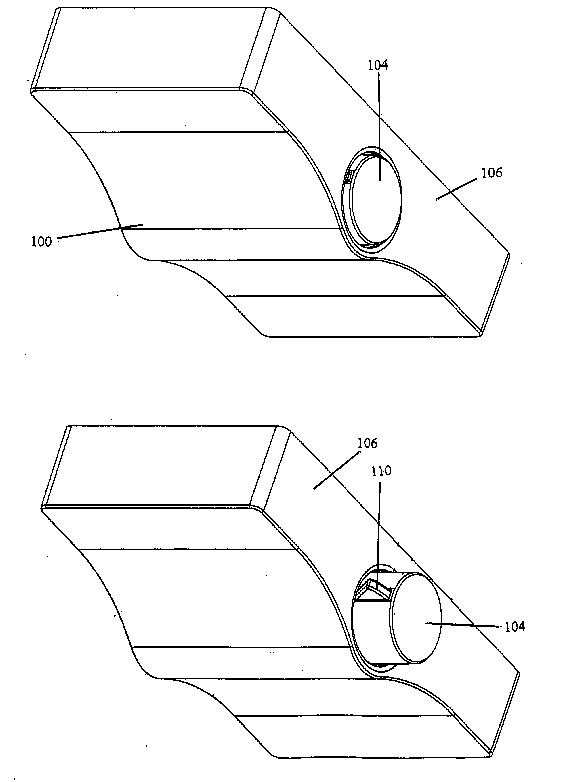
Attention is drawn to the following places, which may be of interest for search:
Mechanisms for selecting, projecting, retracting or locking writing units operated by push-buttons, e.g. mechanisms for ballpoint pens | |
Retractable turn knops for operating switches | |
Switches making use of a heart shaped cam | |
Switches where the operating part is movable both, angularly and rectilinearly, the rectilinear movement being along the axis of angular movement; |
This place covers:
Control members using light sources for illumination and often also for indicating position of control member.
Example document DE102008064283 uses two light sources (15, 16) and colour filters for indicating position:
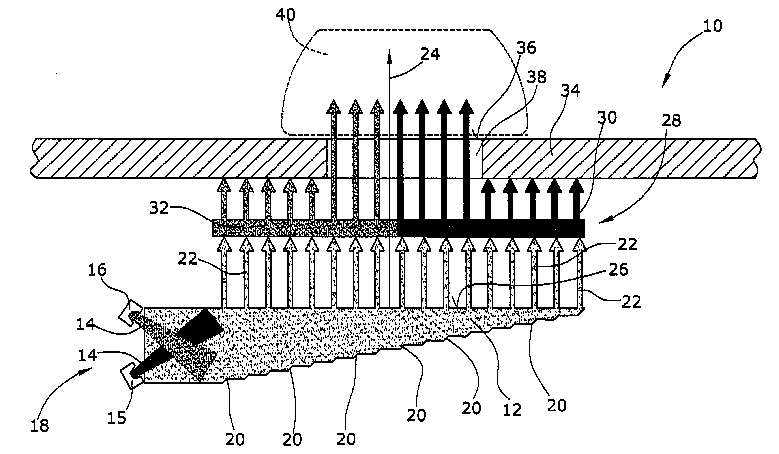
Attention is drawn to the following places, which may be of interest for search:
Illumination of the symbols or distinguishing marks for switches | |
Light-emitting indicators for switches |
This place covers:
Means for fixing the control member (e.g. knop) on the shaft of the control mechanisms
This place covers:
All control members actuated by foot, e.g. pedals
Attention is drawn to the following places, which may be of interest for search:
Arrangements or mounting of propulsion unit control devices in vehicles, e.g. accelerator pedals | |
Brake-action initiating means with locking or release means, e.g. providing parking brake application | |
Disposition of foot actuated brake initiating means | |
Cranks operated by foot power for rider propulsion of wheeled verhicles | |
Arrangements for, or adaptations to engine control initiation means, e.g. electric pedals | |
Control inputs for transmission control depending on the position of the accelerator pedal, e.g. kickdown signal |
Attention is drawn to the following places, which may be of interest for search:
Arrangements or fittings on vehicles movable from an operative to an out-of-the way position for preventing injuries | |
Arrangements of brake-action initiating means, e.g. disposition of brake pedal with means to prevent injuries in case of collision |
This place covers:
Control means with a second control input (pedal) for controlling the same function. A typical example is an additional brake and accelerator pedal for teaching in an instruction vehicle.
Attention is drawn to the following places, which may be of interest for search:
Alternative steering-control elements, e.g. for teaching purposes; |
Attention is drawn to the following places, which may be of interest for search:
Apparatus for, or methods of, measuring force to foot actuated controls, e.g. brake pedals |
This place covers:
Pedal comprising a central pivot axis mostly used for two opposite functions, e.g. accelerating and braking. Example from WO2011007393:
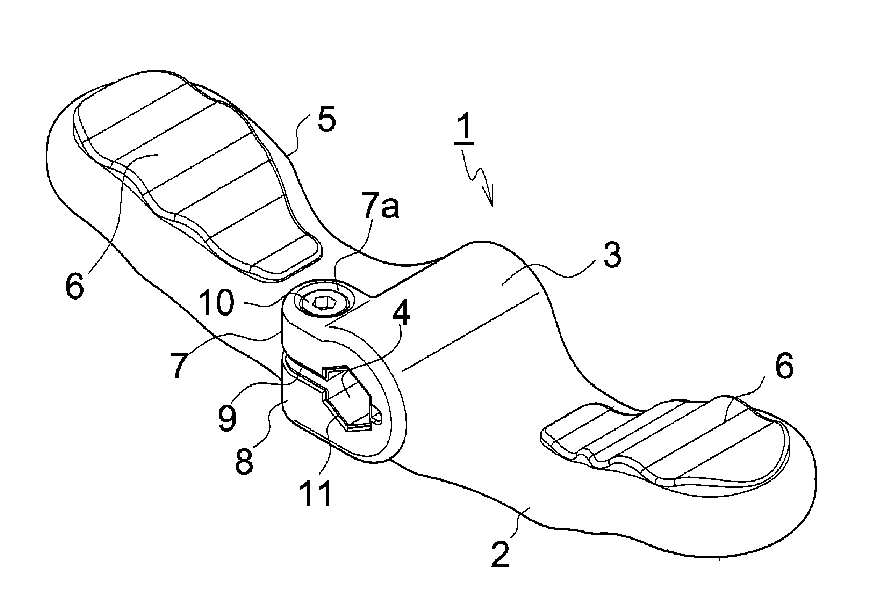
Attention is drawn to the following places, which may be of interest for search:
Connection means for transmitting braking action from initiating means to ultimate brake actuator |
This place covers:
- Auxiliary pedal members connected to pedal plate or pedal lever
- Extention rods for pushing the pedal member
Example figures from GB1173337 and FR2862266
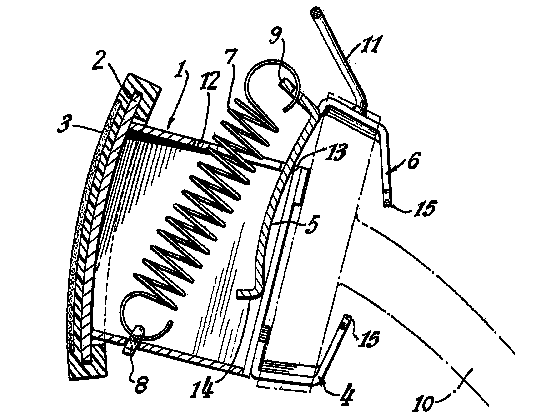
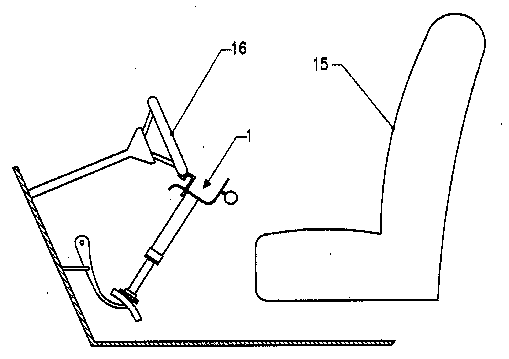
This place covers:
- Manufacturing details of pedals
- Characteristics of different parts that form the controlling member, e.g. the material used
Group G05G 1/503 needs reorganisation because this group does not fit under the scope of group G05G 1/50. Revision request will be launched.
Attention is drawn to the following places, which may be of interest for search:
Serving devices for one-handed persons | |
Operating or control means for protheses | |
Methods or devices enabling invalids to operate an apparatus or a device not forming part of the body |
Attention is drawn to the following places, which may be of interest for search:
Switches operated by a removable member, e.g. key or plug |
This group is not used for classification
This place covers:
Only rests or guides if the rest or guide is integrated with the controlling member, e.g. joystick with a thumb rest.
Attention is drawn to the following places, which may be of interest for search:
Foot-rests for cycles |
This place covers:
Mechanisms that do not transmit a command (part B in the model of the operator control device) e.g.:
- Ratchets
- Pedal force feedback with hysteresis
- Mechanisms with actuators for force feedback
- Mechanisms for limiting the movement of the controlling member
- Mechanisms for returning the controlling member to an inoperative or neutral position
This place covers:
Means for providing feel, e,g, by creating counter force or tactile feed back
Means for signalling that the controlling member is in the neutral or home position
Attention is drawn to the following places, which may be of interest for search:
Arrangements for indicating the position of the controlling member | |
Detent means using spring-loaded balls | |
Means for providing feel for accelerator pedal, e.g. by changing pedal force characteristics | |
Mechanisms for controlling electric contacts with haptic or tactile feedback | |
Mechanisms for controlling electric contacts with detent or indexing means |
Attention is drawn to the following places, which may be of interest for search:
Mechanisms for controlling electric contacts moving the operating part into an inoperative position by an electric drive |
This place covers:
Mechanisms for holding controlling member in particual positions, e.g. by springs or magnetic means
See example document WO2008052676 using two magnets (2) and (3)
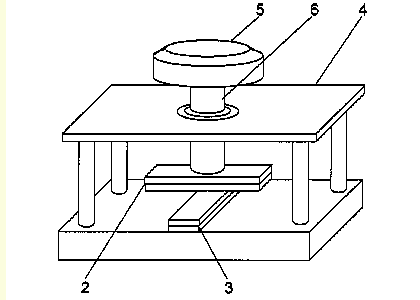
Attention is drawn to the following places, which may be of interest for search:
Positioning and locking mechanisms for vehicle seats |
This place covers:
Mechanisms whereby the allowed position of a controlling member depends on the position of another controlling member
This place covers:
Mechanisms that process the movement (part C in the model of the operator control device) from the operator actuated part to the controlled member.
This place covers:
This group is not active, see definition statement of maingroup
Attention is drawn to the following places, which may be of interest for search:
Wrist joints (Two-dimensional joints) | |
Means for transmitting linear movement in a flexible sheathing, e.g. "Bowden mechanisms" | |
Gearings for interconverting rotary motion and reciprocating motion |
This place covers:
Mechanisms that process the movement (part C in the model of the operator control device) from the operator actuated part to different controlled members, .i.e. the manipulation of a single control input member changes at least two distinct output members.
Controlling members for hand actuation in which movement in two or more ways can occur simultaneously.
The subgroups G05G 9/06, G05G 9/08, G05G 9/085 and G05G 9/10 are not active
Examples of places where the subject matter of this place is covered when specially adapted, used for a particular purpose, or incorporated in a larger system:
Steering control comprising tillers, i.e. hand levers operating on the steering column | |
Manually actuated initiating means for actuating flying-control surfaces | |
Control mechanisms, e.g. control levers, for dregers or soil-shifting machines | |
Selector apparatus for change-speed or reversing- gearings |
Attention is drawn to the following places, which may be of interest for search:
Accessories for surgery or diagnosis using joysticks | |
Apparatus for, or methods of, measuring force of joystick controls | |
Arrangements or instruments for measuring magnetic variables - using galvano-magnetic or magneto-resistive devices, e.g. Hall effect devices | |
Micromanipulators structurally combined with microscopes | |
For pointing devices integrated in a laptop computer | |
Force or tactile feedback applied to a joystick | |
Input arrangements for computers with lever arrangements for operating keyboard cursor control keys in a joystick-like manner | |
Arrangements providing an integrated pointing device in a keyboard, e.g. trackball or mini-joystick | |
Input arrangements for computers using pointing devices displaced or positioned by user, e.g. pens or joysticks | |
Joysticks for switches |
This place covers:
Mechanisms that process the movement (part C in the model of the operator control device) from the operator actuated part to the controlled member. The mechanical control mechanism has more than one input member, e.g. at different locations, and actuates one single output member.
This place covers:
Mechanisms that process the movement (part C in the model of the operator control device) from the operator actuated part to the controlled member. The mechanical control mechanism has more than one input member and actuates more than one output member.
This group is not active
The subject matter: 'Mechanical controls initiating movement automatically due to a specific cause' should be classified in the respective field of application.
This group is not active
The subject matter: 'Mechanical release mechanisms for moving a member after a mechanical trigger signal' should be classified in the respective field of application.
This group is not active
The subject matter 'Mechanical, i.e. neither hydraulic nor electric servo mechanisms with follow-up action should be classified in the respective fields of application.
This place does not cover:
Programme-control systems using cams, discs, rods, drums or the like | |
Time or time-programme switches executing one or more switching actions |
This group is not active
The subject matter 'Mechanical programme control for controlling series of operation' should be classified in the respective fields of application.
This place covers:
Means for adjusting parts of mechanical control means, when not application specific, e.g. for taking up play or backlash of the transmission means
This place covers:
Residiual group for details or accessories of mechanical control mechanisms when not application specific
Examples of places where the subject matter of this place is covered when specially adapted, used for a particular purpose, or incorporated in a larger system:
Sealing means for "Bowden" mechanisms | |
Sealing means for gear selector apparatus | |
Sealing boots for switching devices |